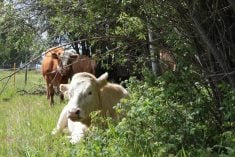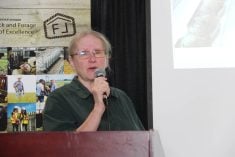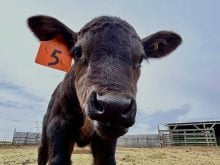With pain medication there may be adjunct treatment with antibiotics but sometimes this is unnecessary. If your veterinarian prescribes NSAIDs (nonsteroidal anti-inflammatory drugs) for pain he/she may choose one for several reasons — label claims, past experience in the field, price per treatment or per 100 pounds, duration of activity, ease of administration, advice of associates or slaughter withdrawal.
When considering NSAIDs there are obviously several things to consider in consultation with your veterinarian.
In dealing with difficult calvings, the clinic I was associated with for years would give calves flunixine IV, thinking swelling and soreness on the legs and potentially ribs were greatly reduced — I believe they were.
Read Also

Cancer agency reclassifies another herbicide ‘probably carcinogenic’
The WHO’s cancer research agency has now put atrazine, a herbicide well known to corn growers, in the same potential-hazard category where the agency put glyphosate.
Calves on IV fluids for scours being treated for the dehydration were routinely given NSAIDs — a practice now proven to also help increase the calf’s appetite.
Also for the cow
With calving season approaching, let’s talk about treating the cow with NSAIDs as well. After calving, the treatment should lead to less obturator paralysis and quicker recovery from vaginal contusions. Appetite is not lost so milk production is maintained. If one follows the Beef Code of Practice, it is an accepted practice to use NSAIDs during major surgical procedures such as C-sections right at the time of delivery or actually just at the beginning of the procedure.
I know from experience that the recovery to C-sections is much more rapid and cows don’t spend the first day moping around. I have used injectable NSAID products, oral meloxicam and now the Banamine TD all with great success. The later two have a greater ease of administration, which makes them both desirable around the calving cows. Most vets are prescribing NSAIDs for all the prolapses they deal with, including a prolapsed uterus. Again, if recovery is quicker, and milk production better the treatment is never a bad thing.
With calving, you need to assess whether it was a hard, medium or light pull. Light means being able to pull by hand with no other assistance. Medium or hard delivery involves applying a calf puller. Remember, timing pulls with the cow’s contractions and going slowly and methodically and applying lots of lubricant can prevent a tough calving. Recognize your skill level and treat accordingly. Was there a tear created, did you pull too fast, was the calf slow to get breathing, or did you hear any unusual pops or snaps indicating tension? Did the cow end up with a little obturator paralysis? Any of these are clues the pull may have been too hard.
From better milking, to increasing appetite, being quicker to mother up, and potentially being quicker to rebreed are all possible benefits when NSAIDs are given to cows after a pull. A lot of producers now have painkillers prescribed for the season and have them close to the chute so they can easily be given.
Keep in mind most product labels do not have “pain control at calving” listed but those changes will come with more research. I think most veterinarians would agree and probably prescribe something like dexamethasone for any cows that are down after a difficult calving. The very potent effect of this steroid seems more effective if given early in cows with obturator paralysis. The treatment can have negative immunosuppressive side effects so often antibiotics are prescribed concurrently.
Valuable welfare tool
There is no doubt the use of NSAIDs as an ancillary treatment or a standalone treatment at calving goes a long way towards a quicker recovery. That is for both in the pair. A tighter pull affects both the cow and the calf so think of treatments for both next time a difficult calving arises.
There are many treatment choices you and your veterinarian need to consider. It is also good for the public to know you as producers give painkillers for difficult birthings to both cow and calf. Cattle have been looked after and observed closely at calving, so these painkillers add another tool in the tool box to improve welfare of the Canadian cattle herd.
Get familiar with the various painkillers out there including their dosage and withdrawal dates. A horse NSAID called phenylbutazone or “Butazone” should never ever be used in cattle production and is a banned product.
Hopefully calving season goes well and you have very few even moderate to tough pulls but if you do it is nice to know NSAIDs can increase the comfort of both cow and calf.















